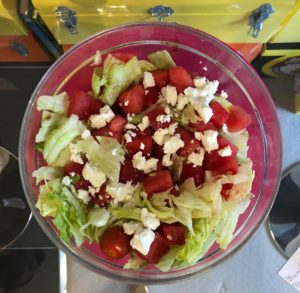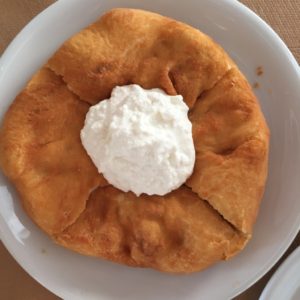There’s more to Greek cheeses than feta
My home country, Greece, has about six thousand islands of which 227 are inhabited (according to visitgreece.gr). Yet, most people would not be able to name more than a dozen, and perhaps would visit even fewer during their lifetimes. Crete, Santorini and Mykonos are amongst the first ones to come to mind, and were the most visited islands in 2019. I’ve always believed that popularity is not a proxy for worth (whether we refer to a travel destination, a cultural product, or a politician), which kind of goes against my democratic values, but let’s save this debate for another time. Back to Greece… There’s so much more to the Greek islands than the tourist-magnets Corfu, Zakynthos or Rhodes. The same is true for the Greek cheeses. Feta may be the most famous, but there are so many Greek cheeses worth learning about and, of course, savoring.
In fact, there are no fewer than 21 Greek cheeses that hold PDO (Protected Designation of Origin) status.
Here are my favorites Greek cheeses (spoil alert: this is a very cheesy post and, of course, not suitable for vegans):
Anthotyro(s)
I have compiled this list of my favorite Greek cheeses in alphabetical order, which is why anthotyro(s) is first. This is a white cheese made with milk, as well as whey, from sheep or goats. Similar to mizithra, and also to the Italian ricotta, anthotyro(s) is produced in both mainland Greece and the islands. There are two variants; the fresh variant is soft and creamy, whereas dry anthotyro(s) is hard. Compared to most cheeses in this list, the fresh variant has a rather neutral taste. Widely considered a lighter alternative to feta, it is often used as a substitute for the latter (especially when people are on a diet). Check out my sweet tomato cheesecake recipe, where you can substitute anthotyro(s) for feta.

Feta
Of course, I couldn’t have left the star ingredient of the world-famous Greek salad out of this list. Made from ewe’s milk, or a mixture of ewe’s and goat’s milk, feta is a fresh cheese that easily crumbles. It has a salty flavor and a rather creamy texture in the mouth. Truth be told, I haven’t always been a fan of feta. As a child, although I enjoyed tyropita (cheese pie usually made with feta), I did not like it in my salad (or on its own). When as a teenager I first tried oven-baked feta, sprinkled with oregano and baked together with tomato and peppers, I was instantly hooked. Over the years, I’ve also become a huge fan of tyrokafteri (or ktipiti), a spicy cheese dip, made with feta, yogurt, olive oil, garlic and chili peppers.
Then, a couple of years ago, I had my first taste of a watermelon and feta salad, when I visited the cosmopolitan island of Mykonos. It simply tasted of summer. The sweetness of the watermelon gave such a lift to the saltiness of the feta. Yet, the combination of these two ingredients in a salad seemed to have escaped the attention not only of myself, but also of my fellow Greeks, anywhere except Mykonos. Check out my recipe for a watermelon and feta salad.

I recently started using feta in cheesecakes, both savory and sweet. Check out my sweet and savory tomato and feta cheesecake recipes.
Graviera
Not to be confused with the Swiss cheese gruyère, graviera is Greece’s second most popular cheese after feta. It is a hard yellow cheese, which can be made from different types of milk; for example, in Crete, graviera is made from ewe’s milk, whereas in Naxos, it is made of cow’s milk. It can be enjoyed as an appetizer, in a sandwich, or fried (in saganaki).
Haloumi
Let’s move to Cyprus now. Haloumi (also spelled halloumi), is by far the most famous amongst the Cypriot cheeses. Made from a mixture of ewe’s and goat’s milk, it is a semi-hard cheese, with a high melting point. This makes it ideal for grilling or frying, which is a popular way to serve halloumi (and my favorite too).
Kaseri
Kaseri is one of the most popular Greek cheeses. It is a hard or semi-hard yellow cheese, made from ewe’s milk. Mainly produced in Northern Greece, it is often sold pre-sliced. It is commonly used in sandwiches, cheese pies, cheese croquettes, crepes and pizzas.
Katiki
Katiki is a wide soft easy-to-spread cheese, made from ewe’s or goat’s milk and produced in the town of Domokos, in mainland Greece. Like anthotyro(s), katiki is a lighter alternative to feta and is often used as a substitute for the latter (especially when people are on a diet). Check out my savory tomato cheesecake recipe, where you can substitute katiki for feta.

Kefalotyri & Kefalograviera
When Greeks say ‘saganaki’, they refer either to a delicious dish (served an appetizer) or to the frying pan in which the dish is prepared and named after. One of the most popular dishes in traditional tavernas, saganaki is meant to be shared (as all the appetizers really). The main ingredient can vary; popular ones include cheese, shrimps and mussels. When saganaki is made with cheese, it is usually made with kefalotyri, a very hard cheese, made from ewe’s and goat’s milk. It can be white or yellow in color, and is produced in both mainland Greece and the islands. Other than saganaki, another popular way to eat kefalotyri is to grate it over freshly-cooked fries.
Saganaki can also be made with other cheeses, such as kefalograviera, graviera, mastelo or talagani. Once the cheese has softened, it is time to serve (with a wedge of lemon). Do not allow the cheese to melt – that will simply be a different dish, called bougiournti (often made with feta and other cheeses).
Kefalograviera is another type of cheese, very similar to kefalotyri. It is produced in mainland Greece.
Mastelo
Mastelo is a soft cheese made with cow milk and produced on the island of Chios. It can be fried and makes a delicious saganaki. It is not to be confused with the Sifniot dish of the same name: lamb or goat marinated in red wine and oven-cooked in ceramic pots made on the island of Sifnos.
Metsovone
I’ve always been a fan of smoked cheeses, including Metsovone. This semi-hard yellow cheese, made from cow’s milk, is produced in and named after the town of Metsovo in mainland Greece.
Mizithra & Xynomizithra
Mizithra is very similar to anthotyro(s), and is also made with milk and whey from sheep or goats. The fresh variant is soft and quite similar to cottage cheese, whereas the dry variant is hard and can be grated. In Greece, Cretan mizithra may be the best known, but Crete is far from the only place producing mizithra.
Xynomizithra (sour mizithra) is a type of mizithra with a rather sour flavor.
Talagani
Talagani is similar to haloumi; it is made with ewe’s milk and produced in Messinia, in the Peloponnese. Like haloumi, it can be fried and makes a delicious saganaki.
Xynotyri
Xynotyri means sour cheese in Greek and has indeed a slightly sour flavor. It is a fresh cheese, soft and easy to spread. In Skyros, it is served with ladopita, bread baked with olive oil, for breakfast or as a side to the main course.

Other cheeses, locally-produced on the islands
In addition to the cheeses already mentioned, there are many other lesser-known ones. These, however, can be difficult to find, even in Greece, unless you happen to visit the place where they are produced, or a deli. Some examples include Hlorotyri (from Santorini), Kalathaki (from the island of Limnos), Kopanisti (from the Cyclades), Krasotyri (from Kos), Ladotyri (from Lesvos), Manoura (from Sifnos), San Mihali (from Syros) and Touloumotyri (from various islands, including the Cyclades and Lesvos). Sifniot manoura is not to be confused with manouri, a white semi-soft cheese produced in Central and Northern Greece.
A personal anecdote and Alex’s vegetable and feta cheese cake
When I was a kid growing up in Greece, the more my mother encouraged me to eat things like carrots, peas and broccoli, the more I would push them to the side of my plate. One day, however, seeing how much I loved cakes, she decided to bake a savory cake, with the vegetables I despised the most. Much to everyone’s surprise, this did the trick. And this is how I started eating vegetables. Nowadays, when I feel home-sick, I bake this cake usually adding a generous portion of feta cheese.

The recipe for my vegetable and feta cheese cake is included in my e-book ‘Baking Therapy: Healthy Cakes & Bakes: Recipes Inspired By My Travels’, available for FREE for every new subscription (for a LIMITED TIME ONLY).
To give you an idea about other recipes included in my e-book, check out my post ‘Healthy cakes & bakes inspired by my travels‘.
Further reading (and baking)
For more recipes with Greek cheeses, check out the following recipes by Akis Petretzikis:
Feta cheese pie (tyropita – with feta and graviera)
Express cheese pies (tyropitakia – with feta and cream cheese)
Mini kourou dough cheese pies (tyropitakia kourou – with feta)
Fluffiest cheese pie (tyropita – with feta and anthotyro)
Greek cheese pies with mizithra and honey (mizithropitakia – with mizithra)
Greek honey pie (melopita – with anthotyro)
Savory Cheesecake with Sweet Cherry Tomatoes (with feta and cream cheese)
Roasted cherry tomato and feta cheesecake (with feta and cream cheese)
Greek spicy cheese dip (tirokafteri -with feta)
Bon Appétit!
Alex
(the soon-to-be-Traveling-again-Psychiatrist)